#Nazca culture
Text
168 New Nazca Geoglyphs Discovered
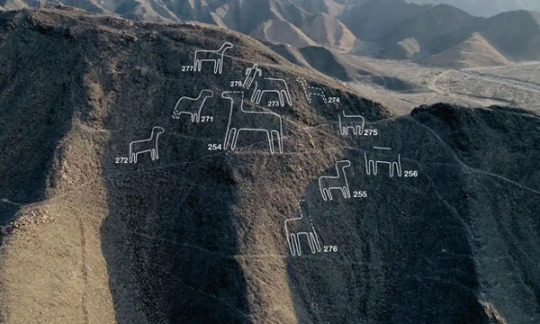
More than 100 new designs discovered in and around Peru's Nazca plain and surrounding areas could bring new information to light about the ancient artworks that have intrigued scientists and visitors for decades. Following two years of field surveys with aerial photos and drones, Peruvian and Japanese researches from Yamagata University reported the discovery of 168 new designs at the Unesco World Heritage site on Peru's southern Pacific coast.
The geoglyphs, huge figures carved into the South American desert, date back more than 2,000 years and depict living creatures, stylized plants and imaginary beings, as well as geometric figures several kilometres long. Jorge Olano, head archaeologist for the Nazca Lines research program, said the newly discovered figures averaged between 2 and 6 meters (6.56 to 19.7ft) in length.
The purpose of the Nazca Lines, which could only be seen from the air, remains a mystery. These new findings, however, are smaller and can be seen from the ground. The figures, iconic vestiges of Peru's rich history, are about a three-hour drive from the capital, Lima. Researchers had already discovered 190 figures in the area since 2004. But the vastness of the terrain they cover has complicated efforts to study and conserve the heritage site.
Yamagata University said the research will be used in artificial intelligence-based surveys to help inform the lines' preservation. Studies from the university in collaboration with Peru's government have helped delineate and protect the area, which is facing threats from urban and economic developments. Some geoglyphs are in danger of being destroyed due to the recent expansion of mining-related workshops in the archaeological park.
Anthropologists, ethnologists, and archaeologists have studied the ancient Nazca culture to try to determine the purpose of the lines and figures. One hypothesis is that the Nazca people created them to be seen by deities in the sky. Another theory is related to astronomy and cosmology, as has been common in monuments of other ancient cultures: the lines were intended to act as a kind of observatory, to point to the places on the distant horizon where the sun and other celestial bodies rose or set at the solstices.
Other theories were that the geometric lines could indicate water flow or irrigation schemes, or be a part of rituals to "summon" water. The spiders, birds, and plants may be fertility symbols. It also has been theorized that the lines could act as an astronomical calendar, as proved by the presence of radial centers aligned along the directions of winter solstice and equinox sunset. Researchers believe that the geoglyphs were the venues of events linked to the agriculture calendar. These also served to strengthen social cohesion among various groups of pilgrims, sharing common ancestors and religious beliefs.
8 notes
·
View notes
Photo

Trophy head (shrunken heads) from a grave at Nazca (after Tello)
#shrunken heads#Trophy head#black and white photography#b&w photography#Nazca#grave#Cabeza trofeo#archaeological#Nazca culture#ancient Peru#Peru
138 notes
·
View notes
Text

a 1968 Peruvian stamp from a series on Nazca ceramics
[id: a postage stamp with a ceramic bird-shaped vessel. end id]
599 notes
·
View notes
Text
Time Travel Question 9: Ancient History II and Earlier
These Questions are the result of suggestions from the previous iteration.
This category is for suggestions made too late to fall into the correct grouping.
Please add new suggestions for this category below if you have them for future consideration.
#Trilobites#Time Travel#Malapa Caves#Uffington Chalk Horse#Moche Culture#Nazca Lines Made#Homo Naledi#Cucuteni–Trypillia Culture#Scythians#Yayoi Culture
32 notes
·
View notes
Link
How would you style/use this? Comment below!
#drawing#nazcalines#culture#nazca#peru#animal#enigma#cryptic#enigmatic#fish#geoglyph#history#inexplicable#landmark#monument#mystery#secret#secrecy#tribal#zoomorphic#mysterious
0 notes
Photo
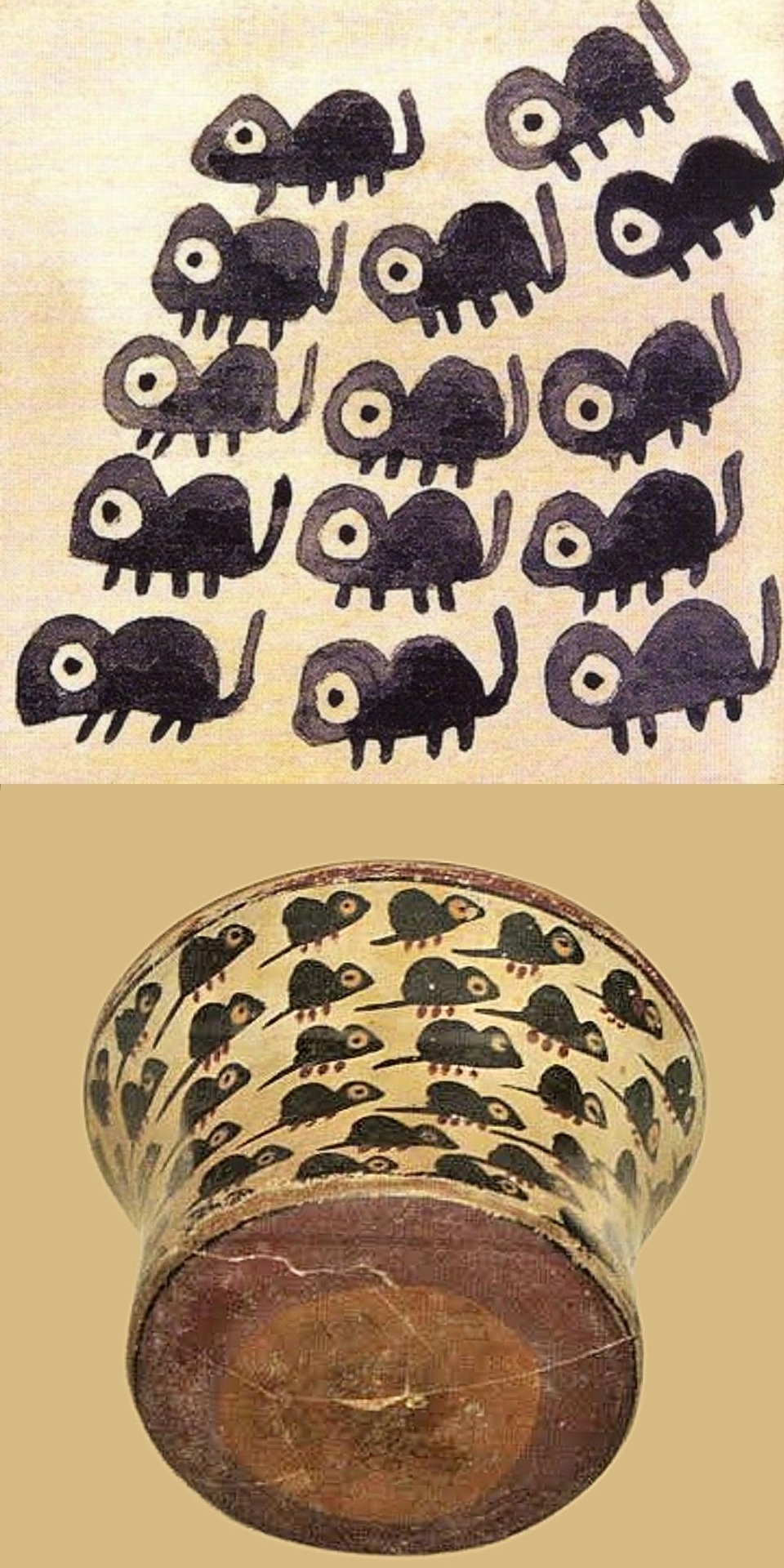
Bowl Depicting a Swarm of Mice. Medium: ceramic and pigment Period: 180 BC - 500 AD. Culture: Nazca; South coast, Peru. Now on display at the Art Institute of Chicago. Illustration by Elena Izcue (1889-1970).
29K notes
·
View notes
Text

Shell inlaid with a kitty, Nazca culture, Peru, 1st century BC - 7th century AD
from The Cleveland Museum of Art
868 notes
·
View notes
Text

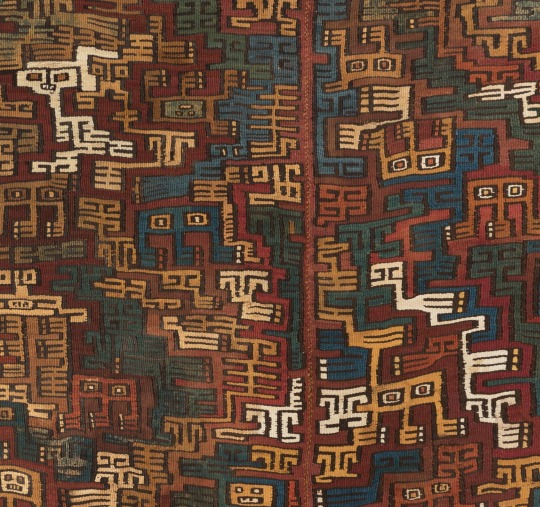
Tunic with Oculate Deities
Peru, Nazca Culture, ca. 300 CE
Dyed camelid wool, 71 x 119 cm
source
113 notes
·
View notes
Text



vase; vessel
Cultures/periods: Nasca
Production date: 100BC-600
Findspot: Nazca
Provenience unknown, possibly looted
Vase, double spout with bridge vessel made of pottery.
British Museum
211 notes
·
View notes
Text
I was just in Detroit, for reasons, and stopped in at their Detroit Institute of Arts
and now I have to compose an email to the curation team
because I believe that they are Wrong about this pot:
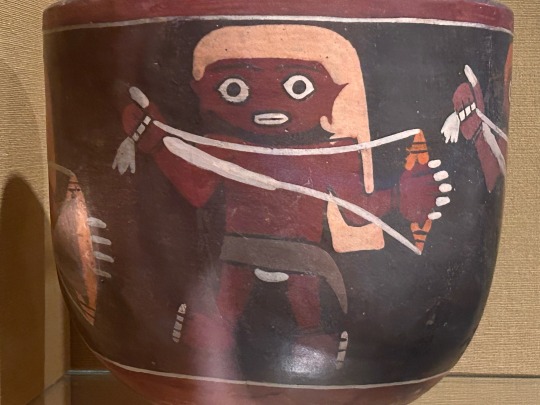
The display label said “Bowl Painted with Children Spinning Yarn, about 400, Ceramic, Unknown artist, Nasca culture, Peru.” (The collection label is “Bowl Decorated with Men Spinning, between 200 BCE and 200 CE, Nazca, Precolumbian” which is a weird discrepancy but not the point)
The point is, this simply isn’t what spinning looks like. I don’t think anyone in human history has attempted to make yarn this way. It is certainly not how the Nasca bead spindle or the modern Southern Quechua pushka are used.
I’m fairly certain that they are actually holding slings, slingshots. Virtually unchanged from the Nasca culture to the modern Southern Quechua, with a tassel at one end and a slit pouch.
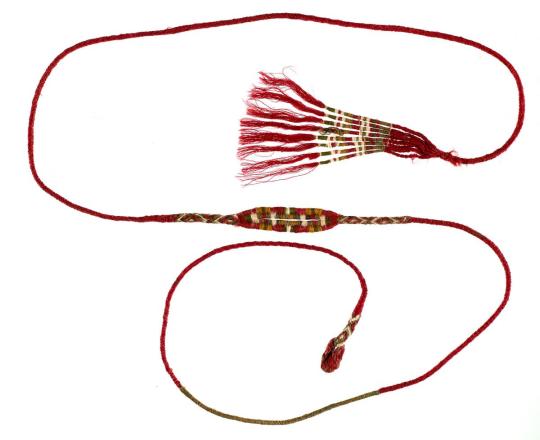
@tlatollotl care to give me a vibe check? before I compulsively pester an institution?
#undescribed#hand spinning#spinning#handspinning#yarnblr#museum#museum curator#nazca#quechua#peru#precolumbian#precolumbian art
125 notes
·
View notes
Text

Double Spout and Bridge Bottle
Nazca
600 CE
The ancient Nasca culture, centered on the south coast of Peru, was known for its fine polychrome pottery. In this desert-like region, the Nasca produced imagery that often related to the worship of supernatural beings who assured agricultural success. The highly abstract mythological figures that appear on the upper register of this bottle are most likely connected to these religious beliefs. The band of faces on the lower register may represent women or, alternatively, warriors with face painting under their eyes.
source
34 notes
·
View notes
Text
Opinion time with Kas:
I absolutely hate those conspiracy theories that are like, "This human wonder was made by aliens!" This is ahistorical at best, and extremely racist at worst. See, when these people make such claims, they're usually referring to non-white human wonders, such as African tribes having knowledge of math and certain star systems or the Nazca Lines in Peru. So these people think non-white ancient civilizations weren't capable of discovering this knowledge themselves or??? But obviously, it makes perfect sense if white people make these discoveries without "alien aid".
This belief system is just so frustrating to me. As a white person, I cannot speak on the experiences of minorities directly, but honestly, these types of conspiracy theories seem incredibly racist to me. I cannot imagine how extremely aggravating it must be for minorities who stem from these ancient civilizations to have their cultural backgrounds and ancient histories reduced to "oh, little green men created all of these world wonders, obviously!" I think it's really important to speak out about and address this issue because of how insanely offensive it can be.
These types of conspiracies are extremely harmful, for a variety of reasons. Please be careful when interacting with them. Keep yourself historically educated, and remember the harm theories like these cause.
-
If any minorities would like to speak on this issue and reblog with additions, I encourage you to do so! I would really love to hear from those directly impacted by these ludicrous claims. Much love to you. 🫂
83 notes
·
View notes
Note
So I found your post on ToTK insightful, but one thing I didn’t see you cover is how according to the narrative, when Zelda went back 10,000 years she went to her distant relatives. It was still her kingdom, just very early. What do you think of how this ties in to the themes you were talking about?
Sure thing! Hope I can address this well.
For those not in the know, this is the post we're discussing--the Orientalism of the Mummy in Dehydrated Ganon.
I also want to qualify this with two things:
I'm not Native. I'm a Black person speaking as someone who also has a heritage closely related to colonial violence and white supremacy, but not someone who can speak for Native people. I can only go by what more experienced people have said and books and readings from them.
I'm using the word "Native" which itself encompasses several different people. I don't use this to imply they are the same or interchangeable with the cultural practices and ideas the Zelda franchise is drawing from.
To your question, I feel it doesn't really change much thematically because neither Zelda nor any of the Hylians in the present day have any cultural features, practices, or attitudes that codify her as a Native person except as a costume or set of resources and knowledge associated with her.
It's not portrayed as if it's her heritage she's been disconnected with, but is effectively portrayed as a white person being introduced to an entirely new culture in how exoticized it is.
With the Zonai, their coded status comes in the form of their way of dressing, the Geoglyphs being Nazca lines, the designs of the shrines, the Zonaite outfit Link has, etc. It also narratively shows up in how it's framed as "archaic" in-game as referenced by the naming of the armor related to the Zonai versus the white rule the land has in the present day and how they're portrayed and characterized around extinction.
It's almost point for point the exact narratives and ideas about Native people colonizers use in real life. Native people imagined as a people who no longer exist but still had worthwhile resources better suited in civilized (white) hands.
A big part of why the myth of Native extinction gets pushed so hard in real life (and in turn is repeated and propagandized in media about Native or Native-coded characters) is because it reframes how we talk about recompense for them.
If you imagine a world and buy into the repeat narrative of Native people all being extinct, there's nobody left to do right by. It helps shape the conversations around policies and decisions by people in power.
Things like environmental justice, land back initiatives, reparations, healthcare access, and many other things Native people advocate for are pushed aside by erasing the people fighting for it. It's a form of colonial erasure meant to justify inaction.
So while Zelda technically is a descendant of the Zonai, the story doesn't really do anything with that to challenge the way it's recreating a colonial narrative about Native people. We've historically seen her as a pure white woman, one whose purity is contrasted with the toxicity and dangerous wickedness of Ganon.
The few times we do get characters with features or a heritage that deviate from eurocentrism (ex. Nabooru, Urbosa, Demise, Princess Hilda, Tetra, Midna, Ganon, Sonia, Telma, etc.) they're either the villain, sympathetic only in how they directly align and submit to Hyrule's power as one of the "good ones" or they're just murdered or erased from the story entirely.
The Gerudo are out looking for boyfriends, but we overwhelmingly see this in relation to white men in-game despite there being numerous dark-skinned Zelda characters in their partners and even in who is spying on them or trying to sneak into Gerudo town as a bunch of creeps.
Zelda as a franchise is very dedicated to positioning whiteness as inherently superior and more desirable.
The (white) Hylians have a god-given right to control and rule, and all of the non-white races of people are better off for it. While Zelda is technically a descendant of a Zonai, we still see her effectively as an innocent and almost holy white woman.
The franchise operates on the idea that some people are born with magic abilities and are essentially destined to rule over others and that any challenge to that superiority is inherently evil. The characters who ever challenge that are either villains or are antagonized and cut down for it.
#tears of the kingdom#totk critical#zonai#can youtubers please recognize this when making lore videos about the zonai#totk spoilers
19 notes
·
View notes
Text
One thing that I noticed about tears of the kingdom is that one possible influence on the culture is that of meso American motifs like I like the geolyphs in tears of the kingdom I feel like there were influenced by the nazca lines of Peru
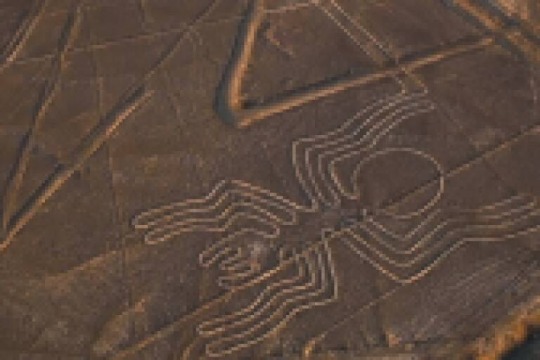

Some of the statues of dragons in Faron look like the motifs in Aztec architecture

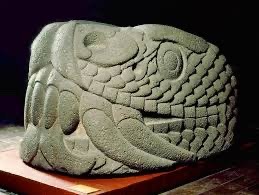
As well the serpent design for the logo


Sorry I just thought it was cool and I just want to to point them out I’m sure someone has already point this out already I just like that they r adding non Eurocentric designs into Zelda and I think it’s neat also meso American art is just neat
27 notes
·
View notes
Photo

Lobster Effigy Vessel
ceramic - Nazca culture - South Coast, Peru - c.300-600 CE
204 notes
·
View notes
Text
REALLY love the art direciton for the zonai in tears of the kingdom. it was already good in BotW but the way the new one brings together disparate influences, obviously heavy japanese stuff but not just (pre)modern japan, a lot of the zonai stuff has a jomon influence, but it connects the sort of jomon line style to both the nazca lines and the line-heavy aztec style and then through there uses a bunch of turquoise tiling reminiscent of mesoamerican turquoise tiling. its so great! feels both distinctly alien in that no cultures art really looks like exactly like that but also very grounded in real art
37 notes
·
View notes